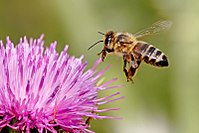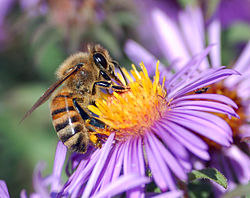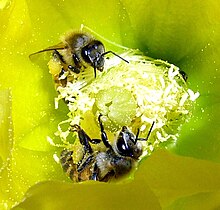
Hi Everybody!!
It is really buzzing around here now that sunshine and warmth returned. I was walking around the buzzing bush when the overwhelming sweet smell of the Honeysuckle Buds nearly knocked me over. I decided to take a break in my chores just to sit under the bush for awhile watching the excited bees, and smell one of the sweetest smells on earth. I took a few snaps of the moment to share with all of You! It wasn't long until one of the buzzing bees landed on the camera and crawled on my hands. I wondered how many of all of you would choose to sit under a buzzing bush to watch the bees and smell the flowers? I have shared some good info from Wikipedia about bees and pollination. As we begin to understand that the pollination process feeds the World, we also see how important bees and other pollinators are to human survival on earth. I urge You to abandon the "shoot to kill" mentality when you see bees.
Pop Quiz: What is the number one reason for declining populations of bees, butterflies and all other pollinators on earth?
Answer: Humans using poisons.
You might ask: What is wrong with this picture? Humans intentionally killing life that sustains us.
I encourage everybody to change the picture and PROTECT life that sustains us! I hope everyone will step up to the plate on this issue and take responsibility to change yourself and your attitude toward bees! How can you make a difference? Plant more Flowers!!!!!!!!!! Enjoy!



http://en.wikipedia.org/wiki/Bee
Bee
From Wikipedia, the free encyclopedia
Bees are flying insects closely related to wasps and ants, and are known for their role inpollination and for producing honey and beeswax. Bees are a monophyletic lineage within the superfamily Apoidea, presently classified by the unranked taxon name Anthophila. There are nearly 20,000 known species of bees in seven to nine recognized families,[1]though many are undescribed and the actual number is probably higher. They are found on every continent except Antarctica, in every habitat on the planet that contains insect-pollinated flowering plants.
Bees are adapted for feeding on nectar and pollen, the former primarily as an energy source and the latter primarily for protein and other nutrients. Most pollen is used as food for larvae.
Bees have a long proboscis (a complex "tongue") that enables them to obtain the nectar from flowers. They have antennae almost universally made up of 13 segments in males and 12 in females, as is typical for the superfamily. Bees all have two pairs of wings, the hind pair being the smaller of the two; in a very few species, one sex or caste has relatively short wings that make flight difficult or impossible, but none are wingless.
The smallest bee is Trigona minima, a stingless bee whose workers are about 2.1 mm (5/64") long. The largest bee in the world is Megachile pluto, a leafcutter bee whose females can attain a length of 39 mm (1.5"). Members of the family Halictidae, or sweat bees, are the most common type of bee in the Northern Hemisphere, though they are small and often mistaken for wasps or flies.
The best-known bee species is the European honey bee, which, as its name suggests, produces honey, as do a few other types of bee. Human management of this species is known as beekeeping or apiculture.
Bees are the favorite meal of Merops apiaster, the bee-eater bird. Other common predators are kingbirds, mockingbirds, beewolves, and dragonflies.
| Bee Temporal range: Early Cretaceous – Recent, 100–0Ma | |
|---|---|
 | |
| Apis mellifera (Honeybee). | |
| Scientific classification | |
| Kingdom: | Animalia |
| Phylum: | Arthropoda |
| Class: | Insecta |
| Order: | Hymenoptera |
| Suborder: | Apocrita |
| Superfamily: | Apoidea |
| Series: | Anthophila |
| Families | |
Evolution
Bees, like ants, are a specialized form of wasp. The ancestors of bees were wasps in the family Crabronidae, and therefore predatorsof other insects. The switch from insect prey to pollen may have resulted from the consumption of prey insects which were flower visitors and were partially covered with pollen when they were fed to the wasp larvae. This same evolutionary scenario has also occurred within the vespoid wasps, where the group known as "pollen wasps" also evolved from predatory ancestors. Up until recently, the oldest non-compression bee fossil had been Cretotrigona prisca in New Jersey amber and of Cretaceous age, ameliponine. A recently reported bee fossil, of the genus Melittosphex, is considered "an extinct lineage of pollen-collecting Apoideasister to the modern bees", and dates from the early Cretaceous (~100 mya).[2] Derived features of its morphology ("apomorphies") place it clearly within the bees, but it retains two unmodified ancestral traits ("plesiomorphies") of the legs (two mid-tibial spurs, and a slender hind basitarsus), indicative of its transitional status.
The earliest animal-pollinated flowers were pollinated by insects such as beetles, so the syndrome of insect pollination was well established before bees first appeared. The novelty is that bees are specialized as pollination agents, with behavioral and physical modifications that specifically enhance pollination, and are generally more efficient at the task than any other pollinating insect such as beetles, flies, butterflies and pollen wasps. The appearance of such floral specialists is believed to have driven the adaptive radiation of the angiosperms, and, in turn, the bees themselves.
Among living bee groups, the "short-tongued" bee family Colletidae has traditionally been considered the most "primitive", and sister taxon to the remainder of the bees. In the 21st century, however, some researchers have claimed that the Dasypodaidae is the basal group, the short, wasp-like mouthparts of colletids being the result of convergent evolution, rather than indicative of a plesiomorphiccondition.[1] This subject is still under debate, and the phylogenetic relationships among bee families are poorly understood.
Eusocial and semisocial bees
Bees may be solitary or may live in various types of communities. The most advanced of these areeusocial colonies[3] found among the honey bees, bumblebees, and stingless bees. Sociality, of several different types, is believed to have evolved separately many times within the bees.
In some species, groups of cohabiting females may be sisters, and if there is a division of laborwithin the group, then they are considered semisocial.
If, in addition to a division of labor, the group consists of a mother and her daughters, then the group is called eusocial. The mother is considered the "queen" and the daughters are "workers". These castes may be purely behavioral alternatives, in which case the system is considered "primitively eusocial" (similar to many paper wasps), and if the castes are morphologically discrete, then the system is "highly eusocial".
There are many more species of primitively eusocial bees than highly eusocial bees, but they have rarely been studied. The biology of most such species is almost completely unknown. The vast majority are in the family Halictidae, or "sweat bees". Colonies are typically small, with a dozen or fewer workers, on average. The only physical difference between queens and workers is average size, if they differ at all. Most species have a single season colony cycle, even in the tropics, and only mated females (future queens, or "gynes") hibernate (called diapause). A few species have long active seasons and attain colony sizes in the hundreds. The orchid bees include a number of primitively eusocial species with similar biology. Certain species of allodapinebees (relatives of carpenter bees) also have primitively eusocial colonies, with unusual levels of interaction between the adult bees and the developing brood. This is "progressive provisioning"; a larva's food is supplied gradually as it develops. This system is also seen in honey bees and some bumblebees.
Highly eusocial bees live in colonies. Each colony has a single queen, many workers and, at certain stages in the colony cycle, drones. When humans provide the nest, it is called a hive. Honey bee hives can contain up to 40,000 bees at their annual peak, which occurs in the spring, but usually have fewer.
Pollination
See also: List of crop plants pollinated by bees
Bees play an important role in pollinating flowering plants, and are the major type ofpollinator in ecosystems that contain flowering plants. Bees either focus on gathering nectar or on gathering pollen depending on demand, especially in social species. Bees gathering nectar may accomplish pollination, but bees that are deliberately gatheringpollen are more efficient pollinators. It is estimated that one third of the human food supply depends on insect pollination, most of which is accomplished by bees, especially the domesticated European honey bee.[citation needed] Contract pollination has overtaken the role of honey production for beekeepers in many countries. Monoculture and the massivedecline of many bee species (both wild and domesticated) have increasingly caused honey bee keepers to become migratory so that bees can be concentrated in seasonally varying high-demand areas of pollination.
Most bees are fuzzy and carry an electrostatic charge, which aids in the adherence of pollen. Female bees periodically stop foraging and groom themselves to pack the pollen into the scopa, which is on the legs in most bees, and on the ventral abdomen on others, and modified into specialized pollen baskets on the legs of honey bees and their relatives. Many bees are opportunistic foragers, and will gather pollen from a variety of plants, while others are oligolectic, gathering pollen from only one or a few types of plant. A small number of plants produce nutritious floral oils rather than pollen, which are gathered and used by oligolectic bees. One small subgroup of stingless bees, called "vulture bees," is specialized to feed on carrion, and these are the only bees that do not use plant products as food. Pollen and nectar are usually combined to form a "provision mass", which is often soupy, but can be firm. It is formed into various shapes (typicallyspheroid), and stored in a small chamber (a "cell"), with the egg deposited on the mass. The cell is typically sealed after the egg is laid, and the adult and larva never interact directly (a system called "mass provisioning").
In New Zealand scientists discovered that three genera of native bees have evolved to open flower buds of the native mistletoePeraxilla tetrapetala. The buds cannot open themselves but are visited by birds such as the tui and bellbird which twist the top of the ripe bud. That action releases a mechanism which causes the petals to suddenly spring open, giving access to the nectar and pollen. However, when observing the native bees in the Canterbury province in the South Island, the scientists were astonished to see the bees biting the top off the buds, then pushing with their legs, occasionally popping open the buds to allow the bees to harvest the nectar and pollen, and therefore aid in the pollination of the mistletoe which is in decline in New Zealand. Nowhere else in the world have bees demonstrated ability to open explosive bird-adapted flowers.[14]
Visiting flowers can be a dangerous occupation. Many assassin bugs and crab spiders hide in flowers to capture unwary bees. Other bees are lost to birds in flight. Insecticides used on blooming plants kill many bees, both by direct poisoning and by contamination of their food supply. A honey bee queen may lay 2000 eggs per day during spring buildup, but she also must lay 1000 to 1500 eggs per day during the foraging season, mostly to replace daily casualties, most of which are workers dying of old age. Among solitary and primitively social bees, however, lifetime reproduction is among the lowest of all insects, as it is common for females of such species to produce fewer than 25 offspring.
The population value of bees depends partly on the individual efficiency of the bees, but also on the population itself. Thus whilebumblebees have been found to be about ten times more efficient pollinators on cucurbits, the total efficiency of a colony of honey bees is much greater due to greater numbers. Likewise during early spring orchard blossoms, bumblebee populations are limited to only a few queens, and thus are not significant pollinators of early fruit.
Pollinator decline
See also : Pollinator decline
From 1972 to 2006, there was a dramatic reduction in the number of feral honey bees in the US, which are now almost absent.[17] At the same time there was a significant though somewhat gradual decline in the number of colonies maintained by beekeepers. This decline includes the cumulative losses from all factors, such as urbanization, systematic pesticide use, tracheal and Varroa mites, and commercial beekeepers' retiring and going out of business. However, in late 2006 and early 2007 the rate of attrition reached new proportions, and the term colony collapse disorder was coined to describe the sudden disappearances.[18] After several years of research and concern, a team of scientists headed by Jerry Bromenshenk published a paper in October 2010 saying that a new DNA-based virus, invertebrate iridescent virus or IIV6, and the fungus Nosema ceranae were found in every killed colony the group studied. In their study they found that neither agent alone seemed deadly, but a combination of the virus and Nosema ceraneae was always 100% fatal. Bromenshenk said it is not yet clear whether one condition weakens the bees enough to be finished off by the second, or whether they somehow compound the other’s destructive power. "They're co-factors, that’s all we can say at the moment. They’re both present in all these collapsed colonies."[19][20][21] Investigations into the phenomenon had occurred amidst great concern over the nature and extent of the losses.[22] In 2009 some reports from the US suggested that 1/3 of the honey bee colonies did not survive the winter,[23] though normal winter losses are known to be around 25%.[24] At the end of May 2012, the Swiss government reported that about half of the bee population had not survived the winter. The main cause of the decline was thought to be the parasite varroa.[25]
Apart from colony collapse disorder, many of the losses outside the US have also been attributed to other causes. Pesticides used to treat seeds, such as Clothianidin, Imidacloprid and Thiamethoxam, have been considered prime suspects.[26][27][28] Other species of bees such as mason bees are increasingly cultured and used to meet the agricultural pollination need.[29]
Native pollinators include bumblebees and solitary bees, which often survive in refuges in wild areas away from agricultural spraying, but may still be poisoned in massive spray programs for mosquitoes, gypsy moths, or other insect pests. Although pesticide use remains a concern, the major problem for wild pollinator populations is the loss of the flower-rich habitat on which they depend for food.[citation needed] Throughout the northern hemisphere, the last 70 or so years have seen an intensification of agricultural systems, which has decreased the abundance and diversity of wild flowers.[30]
Legislation such as the UK's Bees Act 1980 is designed to stop the decline of bees.[31] In April 2013 the European Union announced plans to restrict the use of certain pesticides to stop bee populations from declining further.[32]




http://en.wikipedia.org/wiki/Diervilla
Diervilla
From Wikipedia, the free encyclopedia
| Bush Honeysuckle | |
|---|---|
 | |
| Scientific classification | |
| Kingdom: | Plantae |
| (unranked): | Angiosperms |
| (unranked): | Eudicots |
| (unranked): | Asterids |
| Order: | Dipsacales |
| Family: | Caprifoliaceae |
| Genus: | Diervilla |
Bush Honeysuckle (Diervilla) is genus of three species of deciduous shrubs in the family Caprifoliaceae, all indigenous to eastern North America. The genus is named after aFrench surgeon Dr. Marin Diereville, who introduced the plant to Europe around 1700.
The bush honeysuckles are low in height (1-2 m), of small to medium diameter (1-2 m), and develop into colonies by means of spreading underground rhizomes. Their leaves are simple, opposite and either oval or lanceolate in shape with a toothed edge. The fall color varies between yellow, orange and red. Small tubular flowers, typically pale yellow, are produced in June and July.
- Species
- Diervilla sessilifolia – Southern bush honeysuckle
- Diervilla lonicera – Northern bush honeysuckle (other names Low bush honeysuckle, Dwarf bush honeysuckle, Yellow-flowered upright honeysuckle)
- Diervilla rivularis – Mountain bush honeysuckle (other names Georgia bush honeysuckle, Hairy bush honeysuckle)
Other species formerly included in Diervilla are now treated in the genus Weigela. The bush honeysuckles are commonly confused with the common wild honeysuckle (Lonicera tatarica), or the Japanese honeysuckle (Lonicera japonica), both members of the closely related genus Lonicera.
The British Diervilla national collection is held at Sheffield Botanical Gardens; along with the national collection of the closely related Weigela genus.[1]
Diervilla species are used as food plants by the larvae of some Lepidoptera species including Common Emerald and The Engrailed.

Link to photostudy in G+Album:
https://plus.google.com/u/0/photos/117645114459863049265/albums/5980425450586357521





...this is brendasue signing off from Rainbow Creek. See You next time!
Please STOP using Poison on Bees!

O+O




































